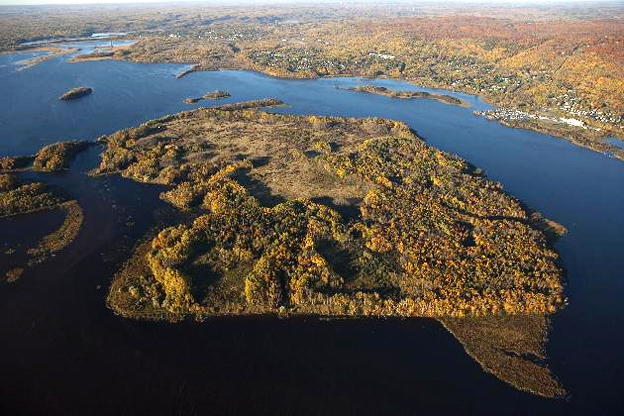

Why bother?
The Strib reports recently:
State and federal regulators announced a $3 million package Friday morning to begin cleaning up a contaminated portion of the St. Louis River in northeastern Minnesota, a vital but threatened estuary for Lake Superior and the Great Lakes.
The grant was announced by the U.S. Environmental Protection Agency (EPA) and the Minnesota Pollution Control Agency (PCA) on the shores of the river’s estuary.
But really: Why bother?
I mean, everyone knows that the St. Louis River estuary will be the place to go to dip the silver service to clean it after that spiffy new open-pit sulfide mine gets opened upriver.
There has never been a sulfide mine that didn’t pollute surface and/or groundwater resources in the history of sulfide mining. Really. The mine that the industry points to as its shining example, the Flambeau Mine near Ladysmith, Wisconsin, was closed in 2006, but five years later, toxic levels of copper and zinc were found:
[ ] DNR testing revealed that 41% of 94 samples taken in 2010 and 2011 had more copper and zinc than standards set by the state to protect aquatic life. The samples were taken from a small stream, a pond and ditches.
The Flambeau Mine was only open for five years, so it obviously didn’t create any permanent employment, either. Employment is the mining companies’ seduction, but it obviously didn’t amount to anything at the Flambeau Mine.
All of the polluted surface water is in areas that are tributary to the Flambeau River. As mentioned, this is the mine that the industry is proud of:
[ ] Flambeau mine has been cited as a model of mineral extraction without environmental harm.
The linked article from the Milwaukee Journal Sentinel continues:
Also, the DNR is deciding whether to officially classify the waters as impaired. That would begin a process of finding ways to turn around the health of the stream. DNR officials say in some cases, property owners are required to pay for or help with the improvements.
The environmental group has pushed for the stream, known as Stream C, to be listed as an impaired water body.
The stream originates in nearby wetlands. It is wet only part of the year and passes through part of the mine property before joining the Flambeau River. Although it runs only intermittently, Stream C is not insignificant.
One DNR official likened the stream and other waters on the site to “capillaries in our blood system.” [emphasis added]
“They are the small channels that move nutrients,” said Tom Aartila, a DNR water resources sources supervisor. “They’re breeding and habitat areas and they are a source of nutrients.”
Here’s Water Legacy’s description of the PolyMet proposal for Minnesota:
The PolyMet NorthMet open pit copper-nickel mine, waste rock heaps and tailings basin dumps will be located in Minnesota’s Lake Superior Basin. The open pit mine would be located on what is now public land in the Superior National Forest, containing high quality wetlands and uplands. The tailings basin would be sited on top of an old tailings basin built in the 1950’s on top of three streams and designed to leak.
Both the open pit mine and tailings basin dump sites drain into the St. Louis River, the largest tributary to Lake Superior, with an important estuary supporting fish for commercial as well as recreational and subsistence fishing.
To see a map of the NorthMet location and vicinity, click here.
Across the country, there is no example where a sulfide mine has been operated and closed without polluting surface or groundwater with acid mine drainage, sulfuric acid and/or toxic metals.
PolyMet is a high risk for permanent pollution of Minnesota’s clean water resources. PolyMet’s own research shows that the location where they would dig their open pit mine has a higher concentration of sulfide (1.04%) than it does of copper (0.57%) or nickel (0.21%). (PolyMet Project Description, October 12, 2012, p. 9). This means that PolyMet would, in effect, be mining sulfur and that more than 99% of the rock that is dug out of its open pit mine will end up as waste.
The PolyMet open pit sulfide mine is proposed for an area that consists of high quality wetlands, most of which have been in existence since the Ice Age, when the glaciers retreated. Draining water from mine pits, could destroy thousands of acres of wetlands in addition to the wetlands directly destroyed by the open pit mine and as a result of mine pollution.
PolyMet’s sulfide mine would create a permanent waste rock heap of 168,000,000 tons and dump 228,000,000 tons of tailings on top of a tailings basin [for taconite mining] that is already leaking and violating water quality standards.
For a close-up of the proposed tailings basin, click here.
PolyMet’s own documents admit that sulfuric acid compounds and metals will leach from waste rock piles and tailings for more than 200 years unabated. (PolyMet Adaptive Water Management Plan, March 7, 2013, p. 61, p. 93)
Two hundred years ago was James Madison’s inaugural year, by the way: 1813. It is pretty naive to think that PolyMet will stick around to abate the problem for anywhere near that long.
So, kids, who you think will be stuck with the problem?
Thanks for your feedback. If we like what you have to say, it may appear in a future post of reader reactions.

